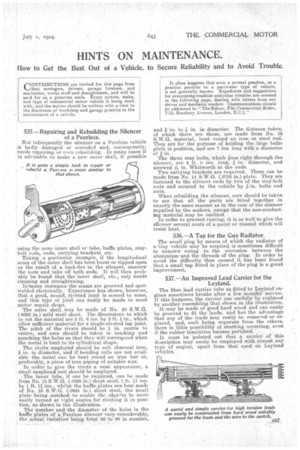HINTS ON MAINTENANCE.
Page 45

If you've noticed an error in this article please click here to report it so we can fix it.
How to Get the Best Out of a Vehicle, to Secure Reliability and to Avoid Trouble.
535 —Repairing and Rebuilding the Silencer of a Peerless.
Not infrequently the silencer on a Peerless vehicle is badly damaged or corroded and, consequently, needs repairing or even rebuilding. In many eases it is advisable to make a new outer shell, if possible
using the same inner shell or tube, baffle plates, staybolt rods, ends, carrying brackets. etc.
Taking a particular example, if the longitudinal seam of the outer shell has been burst or ripped open as the result of a back-fire in the silencer, unscrew the nuts and take off both ends. It will then probably he found that the' inner shell; et.,. only needs cleaning and straightening. In•many instances the seams are grooved and spotwelded electrically. Experience has shown, however, that a good, sound, riveted joint is seconi to none, and this type of joint can easily be made in most motor repair. shops.
The outei. shell,may be made of No. 20 S.W.G. (.0392 in.) mild steel sheet. The dimensions to which to cut the material are 2 ft. 6 ins. by 2 ft. in., which allow sufficient material for A single-riveted lap joint. The pitch of the rivets should be 1 in. centre to centre, and care should -be taken in marking and punching the holes so that they will correspond when the metal is bent to its cylindrical shape.
The rivets employed should be soft charcoal iron, ft in. in diameter, and if bending rolls are not available the metal can be bent round an iron bar or, preferably; a piece of iron piping of suitable size.
In order, to give the rivets a neat appearance, a
• small-anaphead tool should be employed. The inner tube, if one be required, can be made from No 18.S.W.G. (.0495 in.) sheet steel, 1-ft. 11 ins. by 1 ft. 11 ins., whilst the baffle plates are best made of N. 16 S.W.G. (.0625 in.) sheet steel, the small plate being notched to enable the -.idgevto be more easily turned at right.angles for riveting it in posi
tion, as 'in the illtstratien; • ' •
The number and the dim:hetetof the holes in the baffle plates of a Peerless silencer vary considerably, the actual variation being from .50 to 80 in number,
and in. to in. in diameter. The distance tubes, of which there are three, are made from No. 18 S.W.G. material, bent round an iron or steel rod. They are for the purpose of holding the large baffle plate in position, and are 7 ins. long with a diameter of / in.
The three stay bolts, which pass right through the silencer' are 2 ft. 8 ins, long, a in. diameter, and screwed Pein. 'Whitworth at the ends.
Two carrying brackets are required. These can be made from No. 14 S.W.G. (.0785 in.) plate. They are fastened to the silencer ends by two of the stay-bolt
nuts and secured to the vehicle by bolts and nuts.
When rebuilding the silencer, care should be taken to see that all the parts are fitted together in exactly the same manner as in the case of the silencer supplied by the makers, except that the non-conducting material may be omitted.
In order to prevent rusting, it is as well to give the :stouter several coats of a paint or enamel which will resist heat.
536.—A Tap for the Guy Radiator.
The small plug by means of which the radiator of a Guy vehicle may be emptied is'sometirnes difficult to unscrew owing to the corrosion between the aluminium-and the threads of the plug. In order to avoid the difficulty thus caused it has been found that a small tap fitted in place of the plug is a great improvement.
537.—An Improved Lead Carrier for the Leyland.
The fibre lead carrier tube as fitted to Leyland engines sometimes breaks after a few months service. If this happens, the carrier. can usefully be replaced by another resembling that shown in the illustration.
It may be made of good hard wood and can easily be grooved to fit the leads, and has the advantage that any of the leads may easily be removed or replaced, and, each being separate from the others, there is little possibility of shorting occurring, even if the rubber insulation become perished. •
It must be pointed out that a carrier of this description may easily. be employed with almost any type of engine, apart from that used on Leyland vehicles.














































